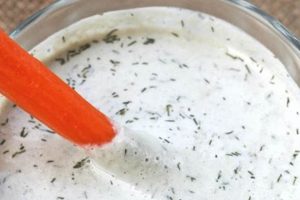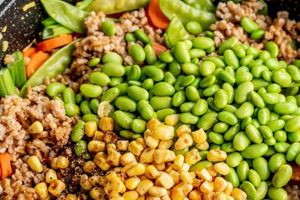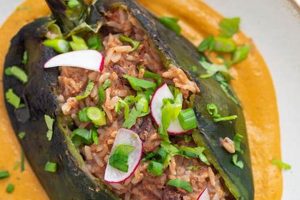The culinary traditions of Lebanon offer a rich tapestry of flavors, often centered around fresh vegetables, herbs, and legumes. Adapting these time-honored dishes to exclude animal products results in a vibrant and healthful cuisine suitable for those adhering to plant-based diets. Examples include variations of hummus, baba ghanoush, tabbouleh, and lentil soups, all inherently free of meat, dairy, and eggs.
The adoption of plant-based meals benefits both personal health and environmental sustainability. Lebanese cuisine’s natural emphasis on vegetables and pulses simplifies the transition to veganism, while still delivering dishes packed with flavor and cultural significance. Historically, many dishes originated as peasant fare, utilizing readily available plant ingredients, thus pre-dating the modern concept of veganism but aligning perfectly with its principles.
Further exploration into this plant-centric culinary landscape reveals a diverse array of dishes adaptable to, or inherently compliant with, a vegan lifestyle. This includes delving into ingredient substitutions, traditional cooking techniques, and specific dish adaptations. The following sections will elaborate on these aspects, offering a deeper understanding of the subject matter.
Tips for Preparing Plant-Based Lebanese Cuisine
Achieving authentic flavors while adhering to a vegan framework necessitates careful ingredient selection and technique. The following guidance offers practical insights for preparing plant-based Lebanese dishes successfully.
Tip 1: Utilize High-Quality Olive Oil: Olive oil forms the base of many Lebanese preparations. Opt for extra virgin olive oil to impart a rich flavor and enhance the overall dish.
Tip 2: Embrace Fresh Herbs: Parsley, mint, and cilantro are essential. Use fresh, locally sourced herbs whenever possible for maximum flavor impact. Dried herbs offer a substitute, but adjust quantities as the flavor intensity differs.
Tip 3: Master the Art of Spice Blending: Lebanese cuisine employs a variety of spices, including cumin, coriander, and allspice. Experiment with blends to find optimal flavor profiles, roasting whole spices lightly before grinding to enhance their aroma.
Tip 4: Leverage Lemon Juice: Acidity balances richness in numerous dishes. Fresh lemon juice brightens flavors and complements the savory elements.
Tip 5: Substitute Tahini Judiciously: Tahini, a sesame seed paste, is crucial for hummus and baba ghanoush. Ensure tahini is fresh and well-stirred to achieve a smooth consistency and avoid bitterness.
Tip 6: Focus on Legume Preparation: Lentils, chickpeas, and fava beans are staple ingredients. Proper soaking and cooking of legumes is vital for optimal texture and digestibility. Avoid overcooking to maintain their structure.
Tip 7: Adapt Dairy-Based Sauces Carefully: Traditional sauces containing yogurt can be replaced with cashew cream or other plant-based alternatives. Adjust seasonings to compensate for the differing flavor profiles.
By adhering to these principles, one can create flavorful and authentic Lebanese dishes that align with plant-based dietary guidelines. This approach balances tradition with innovation, resulting in both satisfying and healthful meals.
The subsequent sections will provide specific recipe adaptations and explore regional variations within this culinary domain.
1. Ingredient Substitution
Ingredient substitution is a fundamental component of crafting plant-based versions of Lebanese cuisine. The success of transforming traditional recipes hinges on the strategic replacement of animal-derived products with plant-based alternatives that maintain, or enhance, the original dish’s flavor profile and textural integrity. A direct cause-and-effect relationship exists: the removal of ingredients like dairy or meat necessitates a comparable substitute to prevent a loss of essential characteristics. For instance, replacing dairy yogurt in a traditional sauce with cashew cream requires careful adjustment of lemon juice and herbs to replicate the desired tanginess and consistency.
The selection of appropriate substitutes is critical. Consider kibbeh, a dish traditionally made with ground meat. A plant-based variation might utilize a combination of lentils, walnuts, and bulgur wheat to mimic the texture and protein content. Similarly, fava bean stews, often enriched with lamb or beef stock, can achieve similar depth of flavor through the use of smoked paprika, vegetable broth fortified with roasted vegetables, and a careful blend of warming spices. Understanding the specific role of each ingredient in the original recipe is paramount to selecting a suitable alternative. This approach also enables modifications for those with additional dietary needs.
Effective ingredient substitution enables culinary innovation while remaining respectful of Lebanese culinary traditions. Challenges arise when attempting to replicate complex flavors precisely; however, a pragmatic and informed approach can yield remarkably satisfying results. Furthermore, ingredient substitution facilitates accessibility of Lebanese cuisine for a wider audience while supporting ethical and environmentally conscious dietary choices. The ongoing exploration and refinement of plant-based alternatives will continue to shape the evolution of the subject matter, allowing it to flourish within diverse dietary frameworks.
2. Spice Profiles
The distinctive character of plant-based Lebanese cuisine is intrinsically linked to its spice profiles. Spices are not merely flavor enhancers; they are integral components that define the authenticity and complexity of each dish. The absence of meat necessitates a heightened awareness of spice usage to achieve depth and umami, traditionally provided by animal proteins. Consequently, careful selection and application of spices become paramount in replicating or enhancing the culinary experience in a meat-free context. For example, the use of smoked paprika in a vegan moussaka can mimic the smoky notes typically associated with grilled eggplant and meat, creating a comparable depth of flavor.
Specific spice blends such as za’atar, a mixture of thyme, sesame seeds, and sumac, play a crucial role in numerous dishes. Za’atar imparts a savory, earthy flavor that complements vegetables and pulses effectively. Similarly, a blend of cumin, coriander, and cinnamon can elevate a simple lentil soup, adding warmth and aromatic complexity. In vegan kibbeh, often made with bulgur wheat and lentils, the judicious use of allspice and mint can replicate the familiar flavors of the original meat-based dish. The preparation method also significantly impacts the final outcome. Toasting spices lightly before grinding releases their essential oils, enhancing their aroma and flavor profile. The understanding of these nuances is crucial for achieving culinary excellence in plant-based renditions of Lebanese classics.
In conclusion, spice profiles serve as a cornerstone in the preparation of plant-based Lebanese dishes. Skillful manipulation of spice blends allows for the creation of flavorful and satisfying meals that honor the culinary traditions of Lebanon while adhering to vegan principles. Challenges may arise in achieving perfect replication of meat-based dishes, however, the thoughtful application of spices offers a pathway to both authenticity and innovation. This critical understanding ensures that plant-based Lebanese fare retains its rich cultural identity and satisfies discerning palates.
3. Texture Replication
The successful adaptation of Lebanese cuisine to a vegan framework hinges significantly on texture replication. Traditional Lebanese dishes often rely on the textures of meats and dairy products to provide a satisfying culinary experience. Therefore, recreating these textures with plant-based ingredients becomes a critical element in developing palatable and authentic-tasting vegan versions. The absence of familiar textures can negatively impact the overall enjoyment of a dish, even if the flavors are accurately reproduced. Effective texture replication involves selecting appropriate plant-based ingredients and employing specific cooking techniques to mimic the mouthfeel of the original dish. This might involve using mushrooms to simulate the meaty texture of shawarma or blending nuts and seeds to create a creamy texture akin to labneh.
Practical application of texture replication manifests in various ways across plant-based Lebanese cooking. For instance, in a vegan version of kibbeh, ground walnuts and lentils can be combined with bulgur wheat to achieve a crumbly, yet cohesive texture similar to the original meat-based version. The addition of finely chopped vegetables contributes further to the textural complexity. Another example is the substitution of labneh (strained yogurt cheese) with cashew cream cheese. By soaking cashews and blending them with lemon juice and salt, a remarkably similar creamy and tangy texture can be achieved, allowing individuals to enjoy dishes like vegan za’atar man’ouche without sacrificing the essential textural component. The careful consideration of ingredient ratios and cooking methods is essential for successfully replicating textures. Overcooking or undercooking certain ingredients can lead to undesirable textures, undermining the overall quality of the dish.
In conclusion, texture replication is not merely a culinary technique but a fundamental aspect of ensuring the success and palatability of plant-based Lebanese recipes. Overcoming the challenges associated with replicating textures requires a thorough understanding of both the original dish and the properties of plant-based ingredients. A focus on achieving optimal texture transforms a simple recipe adaptation into a culinary experience that honors the rich traditions of Lebanese cuisine while remaining consistent with vegan dietary principles. This understanding is crucial for both home cooks and professional chefs seeking to expand the appeal of vegan Lebanese food.
4. Nutritional Balance
The integration of nutritional balance is paramount in plant-based adaptations of Lebanese cuisine. While traditional Lebanese fare often includes a variety of nutrient-dense ingredients, the exclusion of animal products necessitates careful consideration to ensure complete and balanced dietary intake. A direct consequence of removing meat and dairy is the potential reduction of essential nutrients like vitamin B12, iron, calcium, and omega-3 fatty acids. Therefore, thoughtful planning is crucial to address these potential deficiencies within a vegan Lebanese framework. For instance, incorporating fortified plant-based milk alternatives addresses calcium and vitamin B12 concerns, while adding flax seeds and walnuts contributes to omega-3 intake. Iron from lentils and spinach can be enhanced through co-consumption with vitamin C-rich foods like lemon juice, a common ingredient in Lebanese recipes. The importance of this component lies in the preservation of not only the flavors of Lebanese cuisine but also its health benefits.
Practical application of nutritional balance involves strategic ingredient selection and preparation. Lentil soups, a staple in Lebanese cuisine, provide a significant source of protein and fiber. To maximize nutrient absorption, these soups can be enriched with leafy green vegetables, such as spinach or kale, providing iron and other essential vitamins. Hummus, another common dish, offers plant-based protein and healthy fats, and can be paired with whole-grain pita bread for a complete protein source. For recipes traditionally reliant on animal products, substitutions should prioritize nutritional equivalence. Replacing dairy-based yogurt with cashew-based yogurt not only replicates the texture but also offers a source of healthy fats. Vigilant attention to nutrient profiles is therefore essential for those adhering to a plant-based Lebanese diet, particularly for vulnerable populations such as children, pregnant women, and the elderly.
In conclusion, nutritional balance constitutes a cornerstone of healthy plant-based Lebanese cuisine. The exclusion of animal products requires a proactive approach to ensure adequate intake of essential nutrients. Careful ingredient selection, strategic combinations, and informed supplementation, when necessary, are crucial for maintaining optimal health. Challenges exist in achieving perfect nutritional parity with traditional recipes, however, a conscious effort to prioritize nutrient density can result in both flavorful and nutritionally complete dishes. This understanding extends beyond mere recipe adaptation, promoting a holistic approach to plant-based eating within the context of Lebanese culinary traditions.
5. Regional Variations
Lebanese cuisine exhibits significant regional diversity, directly impacting the composition and characteristics of its plant-based adaptations. Geographic location, climate, and historical influences shape the availability of ingredients and traditional cooking methods, resulting in distinct regional variations within the vegan culinary landscape. For example, coastal regions, with abundant access to seafood traditionally, utilize different spice blends and vegetable combinations compared to mountainous areas where meat preservation techniques are more prevalent. The adaptation of recipes must consider these regional nuances to maintain authenticity and cater to local preferences. The removal of animal products necessitates strategic adjustments to leverage regional plant-based resources and techniques. A “cause-and-effect” dynamic is clearly visible; certain regions may have an easier transition due to a more historically plant-forward cuisine.
The Bekaa Valley, known for its fertile agricultural land, offers a rich array of vegetables and legumes that naturally lend themselves to vegan preparations. Dishes originating from this region may incorporate more fresh produce and emphasize techniques like roasting or grilling vegetables to enhance their flavors. In contrast, regions closer to the Mediterranean Sea might focus on utilizing seaweed, olives, and preserved lemons to create flavorful vegan alternatives to traditionally seafood-based preparations. As an additional note, the cultural importance of specific dishes varies from region to region, further impacting adaptation priorities. What might be considered a daily meal in one region could be a celebratory dish in another, influencing the care and attention given to its plant-based transformation. This element emphasizes the practical significance of understanding how regional variation serves as a component to vegan Lebanese recipes.
In conclusion, regional variations represent a crucial factor in the development and appreciation of plant-based Lebanese cuisine. While challenges exist in perfectly replicating the culinary landscape of all regions in a vegan context, an awareness of these distinctions is essential for authenticity and flavor. The adaptation of traditional recipes benefits from leveraging regional plant-based resources and cooking techniques, ensuring that the vegan versions remain true to their cultural origins. This understanding not only enhances culinary experiences but also promotes a more nuanced and comprehensive appreciation of Lebanese food culture.
Frequently Asked Questions Regarding Lebanese Vegan Recipes
This section addresses common inquiries and misconceptions surrounding the creation and consumption of plant-based Lebanese dishes. Clarification on ingredient substitutions, nutritional considerations, and authenticity concerns is provided.
Question 1: Are Lebanese vegan recipes inherently less flavorful than traditional recipes containing meat and dairy?
Not necessarily. The effective use of herbs, spices, and plant-based umami enhancers such as dried mushrooms or smoked paprika can replicate or even surpass the flavor profiles of traditional dishes.
Question 2: Can traditional Lebanese dishes be easily adapted to be vegan?
Many Lebanese dishes are naturally plant-based or require only minor modifications. Legume-based dishes like hummus and falafel are inherently vegan. Adaptations may involve substituting dairy yogurt with cashew cream or replacing meat with lentils or mushrooms.
Question 3: How can adequate protein intake be ensured when following a Lebanese vegan diet?
Lebanese cuisine utilizes a variety of protein-rich plant foods, including lentils, chickpeas, fava beans, and nuts. Combining these ingredients strategically ensures a sufficient protein intake.
Question 4: Are vegan Lebanese recipes culturally authentic?
While certain dishes may require adaptation, the core flavors and culinary techniques of Lebanese cuisine can be preserved in vegan versions. Emphasis on fresh herbs, spices, and quality ingredients contributes to authenticity.
Question 5: Is it more expensive to prepare vegan Lebanese recipes compared to traditional recipes?
The cost varies depending on the ingredients selected. Locally sourced produce and legumes are often inexpensive. Specialized vegan substitutes may incur additional costs but are not always essential.
Question 6: How can one find reliable resources for plant-based Lebanese recipes?
Numerous cookbooks, websites, and culinary blogs specialize in plant-based cuisine, including vegan adaptations of Lebanese dishes. Cross-referencing multiple sources and experimenting with recipes is recommended.
In summary, the preparation of plant-based Lebanese cuisine presents both opportunities and challenges. Through informed ingredient selection, mindful cooking techniques, and a commitment to cultural authenticity, satisfying and nutritious vegan dishes can be achieved.
The subsequent section will explore specific recipes and culinary techniques in greater detail.
Conclusion
This exploration has demonstrated the viability and richness of plant-based adaptations within Lebanese culinary traditions. Key elements include thoughtful ingredient substitutions, nuanced spice profiles, effective texture replication, balanced nutrition, and awareness of regional variations. The creation of flavorful and authentic “lebanese vegan recipes” requires a deep understanding of both the original dishes and the potential of plant-based ingredients to recreate or enhance them.
The continued development and refinement of these recipes represent an ongoing evolution of Lebanese cuisine, catering to a growing interest in plant-based diets without sacrificing cultural heritage. Further exploration and experimentation are encouraged, ensuring the continued accessibility and enjoyment of these healthful and flavorful dishes. It is through this collective effort that “lebanese vegan recipes” can cement their place as a significant and respected aspect of global culinary diversity.







